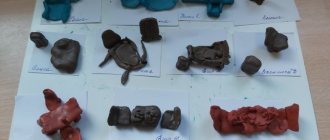Russian folk barkers before the start of the game
I’m melting, melting, I’m flying into the game, I’m inviting you all, but I won’t tell you which one! I'll tell you the barker. Whoever is late flies into the sky. Tai, Tai, fly in. Have fun and play! We accept everyone into the game and don’t offend anyone. It's time to play Cheerful children Let our laughter sound around Get together in a circle! I invite the kids to a fun game, and whoever we don’t accept, we’ll lift by the ears. The ears will be red. So beautiful before.
In any Russian game there is always a driver or presenter. There are usually many people willing to play this role, but you need to choose one, sometimes two, which is what counting rhymes and tongue twisters are used for.
Children love humorous, funny counting poems and quickly remember them. All participants stand in a circle, in a row, and one of them goes to the middle, loudly. Pronouncing the words clearly, he recites a rhyme, for example:
Senior group. Senior preschool age. Children 5-6 years old
Round dance games for senior preschool age Round dance games for senior preschool age. Round dance games give an appeal to the cultural and historical past of their people , which is a very important part for raising children. Studying the history of the people , their culture gives in the future with respect and interest...
Sports entertainment “Games of our yard” in the senior group Sports entertainment “ Games of our yard ”
- senior group.
Objectives: educational - to introduce children to outdoor and folk games ; developing – develop dexterity, flexibility, coordination of movements; educational – create a positive emotional mood….
Games to introduce children to Russian folk culture
Author:
Safarova Bopozhan Kusaimovna,
teacher
MADO kindergarten No. 186 in Tyumen
Didactic and outdoor games to introduce children to Russian folk culture
One of the important tasks of work on this topic is to create a diverse developmental environment for each child in order to give him the opportunity to express himself. In the course of familiarization with a particular craft, appropriate material is introduced into the playing corners. Practical material and teaching aids have been selected, which include authentic items of folk crafts - Khokhloma, Dymkovo toys, Zhostovo, nesting dolls, Filimonovskaya toys, Gorodets products; illustrations, albums for each type of folk art.
One of the means of introducing people to folk art is educational games, which occupy the most important place in a child’s life. They expand the child’s understanding of the world around him, teach the child to observe and identify the characteristic features of objects, distinguish them, and also establish simple relationships.
In the “art center” I picked up didactic and educational games, some didactic aids were created with my own hands.
Purpose of the games: to consolidate children’s knowledge about folk crafts and their characteristics; develop imagination, attention, sensory perception, perseverance, hand-eye coordination, speed, endurance, fine motor skills, cultivate respect and love for folk art.
I would like to bring to your attention a number of educational games to familiarize children with the history and culture of the Russian people.
Didactic manual “Lay out the pattern”
Goal and objectives: Children’s ability to lay out Khokhloma painting patterns from details. Promote the development of fine motor skills of the child's hands. Equipment: a dark-colored tray made of fabric, red berries, green leaves and yellow flowers made from felt.
Progress of the game: Compose a Khokhloma painting pattern from individual elements.
Didactic manual “Arrange the berries”
Goals and objectives: Practice counting objects and finding equal quantities according to the pattern. Strengthen the patterns of Khokhloma painting. Develop visual perception, attention, memory and fine motor skills of the hands.
Equipment: 6 paper cups with an element of the Khokhloma pattern depicted on them according to the intended pattern, red knitted berries 21 pcs.
How to play: Place into cups as many berries as shown on the cups.
Outdoor bowling game “Knock down the matryoshka”
Goal and objectives: Practice rolling the ball into bowling pins. Develop eye, accuracy, endurance, speed. Contribute to the formation of a desire to strive for the intended goal.
Equipment: 6 large paper cups with images of nesting dolls, the sundresses of which have stylized patterns, a knitted stuffed ball.
Progress of the game: Children look at the cups-skittles, talk about how the nesting dolls are painted, and compare outfits. In mobile game, children are asked to knock down pins - cups, pins standing at a certain distance. Points are awarded for knocked down pins; whoever scores the most points is the winner. You can play in teams.
Outdoor game “Harness the horse”
An ancient and popular game.
Goal: to teach children to move together, one after another, to coordinate their movements, and not to push the person running in front, even if he is not moving very fast.
Equipment: Self-made reins from fabric with Khokhloma painting patterns.
Progress of the game: One represents the “horse”, the other – the “groom”. Each "groom" has "reins". The “groom” controls the horse with the help of reins. They can also follow the instructions of the teacher.
The results of the work are: 1. Children use nursery rhymes, counting rhymes, riddles, and chants in active speech. 2. They know how to play Russian folk outdoor games using counting rhymes. 3. Meaningful and active participation of children in Russian folk holidays (they know the name of the holiday, sing songs, perform ditties, read poetry). 5. Use the attributes of Russian folk culture in independent activities. 6. Treat household items and works of folk art with care.
The use of folk crafts deepens children's knowledge of folk art, develops aesthetic taste, and enriches visual creativity. Most students are able to distinguish between products of different folk crafts and draw patterns based on products of folk arts and crafts.
Thus, preschool children develop knowledge about the cultural heritage of the Russian people, an emotionally charged sense of children’s involvement in the heritage of the past.
Literature: T.S. Komarova Children's artistic creativity. For working with children 2–7 years old. Methodological manual for educators and teachers
Internet resources:
https://ped-kopilka.ru/blogs/ala-ivanovna-efimova/narodnye-promysly.html
“Certificate of publication in the media” Series A No. 0007295
We invite teachers of preschool education in the Tyumen region, Yamal-Nenets Autonomous Okrug and Khanty-Mansi Autonomous Okrug-Yugra to publish their teaching materials: - Pedagogical experience, original programs, teaching aids, presentations for classes, electronic games; — Personally developed notes and scenarios of educational activities, projects, master classes (including videos), forms of work with families and teachers.
Why is it profitable to publish with us?
1. “Kindergartens of the Tyumen Region” is an officially registered specialized media outlet at the federal level. 2. The activities of the editorial office are supported by the Department of Education and Science of the Tyumen Region 3. We issue a “Certificate of Publication” in the media. 4. The document has a unique number, is entered in the register, has the original seal of the editorial office of the online publication and signature. 5. “Certificate of publication” in the media is sent to the author in both paper and electronic versions.
Details >>>
Sample “Certificate of publication of author’s methodological material in the media.”pdf
Share
"Folk outdoor games in preschool educational institutions"
- February 3, 2014
Competition “My Pedagogical Initiative - 2013”
Nomination “Methodological work in preschool educational institutions”
“Give children more and more general, human, world content, but mainly try to introduce them to this through native and national phenomena.” V. Belinsky.
Today we are beginning to look at many things differently, we are rediscovering and re-evaluating many things, this relates to the past of our people. Unfortunately, most people are very superficially familiar with Russian folk art. The native culture should become an integral part of the child, the beginning that gives rise to personality. You need to start introducing folk art from preschool age and best of all through play.
Tasks:
- introduce children to Russian folk art (games, counting rhymes),
- develop interest in the history of folk culture and folklore.
Our childhood is directly connected with the game. Children love to play various games, but most of all they love outdoor games. There are different types of outdoor games: plot-based and plot-free. But I would like to talk separately about folk outdoor games.
Folk games are accessible to children in their content. In the game, children improve their physical abilities and skills, increase motor activity, and develop physical qualities. Through folk games, children expand their horizons and gain ideas about the world around them. The rules of these games have great educational significance. They determine the entire course of the game, regulate the actions and behavior of children, and their relationships.
Folk games are often accompanied by funny moments, children’s favorite counting rhymes, drawing lots, and nursery rhymes, which have great aesthetic significance and constitute the most valuable, unique gaming folklore. So, for example, the beginnings are like a game prelude, they make it possible to quickly organize the players, set them up for an objective choice of the leader, unconditional compliance with the rules. In addition to counting rhymes, there are draws, which also create an emotional mood and captivate the game itself.
Clear counting rhymes, melodious and funny sing-alongs, entertaining dialogues are quickly and firmly remembered and are spoken with pleasure by children in their everyday games. Folklore is passed down orally from generation to generation and never grows old.
The teacher, creatively using the game as an emotional and imaginative means of influencing children, awakens their interest and imagination, achieving active performance of game actions. During the game, the teacher attracts the children’s attention to its content, monitors the accuracy of movements that must comply with the rules, the dosage of physical activity, gives brief instructions, supports and regulates the emotionally positive mood and relationships of the players, teaches them to act deftly and quickly in the created game situations, provide comradely support, achieve a common goal and experience joy at the same time.
The teacher should remember that his main task is to teach children to play actively and independently. Only in this case will they learn to regulate the degree of attention and muscle tension in any game situation, adapt to changing environmental conditions, find a way out of a critical situation, quickly make a decision and carry it out, show initiative, i.e. preschoolers acquire important qualities they need in the future.
Folk outdoor games in combination with other educational means represent the initial stage of the formation of a harmoniously developed, active personality, combining spiritual wealth, moral purity and physical perfection. When working with children, the teacher must remember that childhood impressions are deep and indelible in the memory of an adult. They form the foundation for the development of his moral feelings, consciousness and their further manifestation in socially useful and creative activities.
In the practice of preschool education, folk games are rare.
I believe that the proposed scenario will be of practical interest to those who want to expand children’s understanding of folk art. The task of the teacher and parents, or rather, their sacred duty, is to teach them to love their Motherland.
Physical education leisure for senior preschool age.
Lesson summary. Russian folk games.
Author: Kotova Elena Leonidovna, physical education instructor, MBDOU kindergarten No. 16 “Alenka”, Spassk-Dalniy, Primorsky Territory.
Russian folk games for speech development. Senior group
Russian folk games for speech development
What are you doing? (Russian folk game) Activate verbs and verb forms in speech that denote professional actions. The game is played outside. The leader assigns jobs to all the players sitting in the circle: cook dinner, bake bread, repair a car, sew, knit, etc. Each participant digs a hole for himself, sits down next to him, takes a stick and twirls it in the hole. The leader in the middle of the circle also twirls the stick in the hole. He assigns everyone some common task, for example, he says: “Bake bread, everyone!” And everyone starts twirling their chopsticks in the hole and repeating loudly: “I’m baking bread, I’m baking bread.” At this time, the presenter unexpectedly turns to someone with the question: “What are you doing?” The person asked must immediately name the work assigned to him personally, for example: “I sew a dress.” If he makes a mistake and names the general one (“I’m baking bread”) or hesitates, he changes places with the leader. Mail (Russian folk game) Correlate the verb with the action it denotes. The leader is selected (appointed by lot). The rest of the players think of one action. A dialogue begins between him and the rest of the game participants. - Ding, ding, ding! - Who's there? - Mail. - Where? — From Ryazan (any city). - What are they doing there? - They dance (sing, laugh, swim, fly, jump, croak, quack, dive, drum, knock, wash, etc.). All players must depict the named action. Anyone who didn’t have time or portrayed it incorrectly becomes the driver. King (Russian folk game) Correlate the movement with a word denoting a profession. One of the players becomes a king at will. The rest are considered employees. The king sits down in a certain place, and the workers step aside and agree on what work they will be hired for by the king. Having agreed, they come up and say: Hello, king! - Hello! - the king answers. - Do you need workers? - Needed. - Which? Children begin to use expressive movements to portray people of different professions (sawyer, lumberjack, plowman, digger, seamstress, cook, laundress, etc.). The king must say what everyone is doing, and if he immediately names everything correctly, then the workers run away to a pre-designated place. The king catches them, and whoever catches him becomes king, while the rest go back to agree on the work. If the king names what is shown incorrectly, the children repeat the movements until he finally identifies all the works correctly. The king can catch the players only until they reach the designated place. If he doesn't catch anyone, he remains king for the next game. The main thing in this game is to choose a job that is difficult to guess, and thus force the king to play his role longer. Kuzovok (Russian folk game) Form diminutive names. The children sit down to play. One of them puts a basket on the table and says to his neighbor: Here’s a box for you, Put what’s ok in it, If you say anything, you’ll give the deposit. Children take turns naming words with an accent ending in -ok, for example: “I will put a ball in the box (lock, knot, box, boot, shoe, stocking, iron, collar, sugar, bag, leaf, petal, bun, cap, comb and so on.). Words should not be repeated. If someone makes a mistake, they put the deposit in the basket. At the end of the game, pledges are played out: the basket is covered with a scarf, and one of the children takes out the pledges one by one, after asking: “Whose pledge will be taken out, what should he do?” Children take turns assigning ransom to each pledge, for example, jumping around the room on one leg or asking a riddle or singing a song. Guess the nickname Choose words to describe the toy characters. Children come to visit with toys, for example, a fox and a puppy. They offer to guess their names. The adult explains that the guests should have names so that they can immediately guess who is who. He asks: “What do you guys think, what is the little fox’s name?” The little fox is cunning and has a fluffy tail. He is red, almost orange, like the sun. Did you guess it? What can you call a little fox? Fox, is your name Ryzhik? When all the guesses have been made, the adult prompts on behalf of the little fox: “My name is...” and chooses the most interesting nickname. The puppy is characterized similarly. He is cheerful, funny, jumps well, fast, black as coal. The children are looking for a name for the puppy. The puppy and the fox offer riddles to the children. What is the name of their gnome friend (squirrel, bunny, etc.), who is shy about everything? Who loves to sleep? Always grumpy? Does he read endlessly? Loves cleanliness?
We recommend watching:
Speech games for children Speech development in children. Tips for parents Games for developing the speech of preschoolers through improvisation The game is an exercise in the correct use of the verb want for children 5-6 years old
Similar articles:
Games for the development of speech breathing in the middle and senior groups
Speech development in children 3-4 years old with developmental disabilities based on Suteev’s fairy tales
Games for the development of attention and speech in children 4-6 years old
Letter games for children 4-6 years old
Tasks in pictures for speech development for children 3-5 years old



